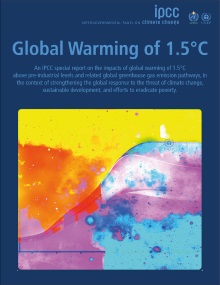The IPCC Misses the Mark on Solar Geoengineering
The Intergovernmental Panel Climate Change poorly portrays the “institutional and social constraints to deployment related to governance”
Not long ago, I re-read the top-level messages from the Intergovernmental Panel Climate Change (IPCC) on solar geoengineering’s governance issues. The Summary for Policymakers of most recent broad report, Global Warming of 1.5°C (SR1.5), says, in full:
Solar radiation modification (SRM) [i.e. solar geoengineering] measures are not included in any of the available assessed pathways. Although some SRM measures may be theoretically effective in reducing an overshoot, they face large uncertainties and knowledge gaps as well as substantial risks and institutional and social constraints to deployment related to governance, ethics, and impacts on sustainable development. They also do not mitigate ocean acidification.
And in that of the Synthesis Report its most recent (although now a bit dated) full Assessment Report:
Solar Radiation Management (SRM) involves large-scale methods that seek to reduce the amount of absorbed solar energy in the climate system. SRM is untested and is not included in any of the mitigation scenarios. If it were deployed, SRM would entail numerous uncertainties, side effects, risks and shortcomings and has particular governance and ethical implications. SRM would not reduce ocean acidification. If it were terminated, there is high confidence that surface temperatures would rise very rapidly impacting ecosystems susceptible to rapid rates of change.
 These two paragraphs struck me as odd. Only 12 of 146 words speak of solar geoengineering’s efficacy, and even this clause is qualified with “although” and “theoretically.” Most of the remaining words address solar geoengineering’s risks and limitations. Furthermore, these reports give no reason for excluding solar geoengineering from their scenarios. Yet evidence from modeling consistently indicates that a judicious use of solar geoengineering could greatly reduce climate change. This was especially clear by the time of SR1.5, which, in a box toward its end (pp. 349-350), concludes “with high agreement that [stratospheric aerosol injection] could limit warming to below 1.5°C,” a goal that is out of reach through emissions reduction alone. (At the time, I called this “burying the lede.”)
These two paragraphs struck me as odd. Only 12 of 146 words speak of solar geoengineering’s efficacy, and even this clause is qualified with “although” and “theoretically.” Most of the remaining words address solar geoengineering’s risks and limitations. Furthermore, these reports give no reason for excluding solar geoengineering from their scenarios. Yet evidence from modeling consistently indicates that a judicious use of solar geoengineering could greatly reduce climate change. This was especially clear by the time of SR1.5, which, in a box toward its end (pp. 349-350), concludes “with high agreement that [stratospheric aerosol injection] could limit warming to below 1.5°C,” a goal that is out of reach through emissions reduction alone. (At the time, I called this “burying the lede.”)
Wondering what the IPCC authors meant by “institutional and social constraints to deployment related to governance” and “particular governance and ethical implications,” I dived into the reports’ characterization of solar geoengineering’s regulatory, political, social, and ethical challenges. (These are largely considered only in the recent two reports, cited above.) I grouped the report’s claims into seven categories:
- that solar geoengineering could lessen mitigation;
- that its termination would cause severe climatic impacts;
- that researching solar geoengineering would create a “slippery slope” to its inevitable and unwanted use;
- that decisions to use it could be contrary to democratic norms;
- that the public may not accept solar geoengineering;
- that it could be unethical; and
- that decisions to use solar geoengineering could be unilateral.
I was surprised to find that most of these are supported poorly or not at all. For six of these seven challenges, the reports’ claims are variously speculative, fail to consider both advantages and disadvantages, implicitly make unreasonable negative assumptions, are contrary to existing evidence (several times clearly misrepresenting the cited academic publications!), and/or are meaninglessly vague. Only the last set of claims — potential unilateral action — is stated coherently and consistently with evidence and scholarship. Here is one example, that of the “slippery slope,” excerpted from my new publication “Is Solar Geoengineering Ungovernable? A Critical Assessment of Governance Challenges Identified by the IPCC“:
As stated in AR5 [the Fifth Assessment Report], “research might make deployment inevitable.” SR1.5 is vaguer, passively saying that “The argument that SRM research increases the likelihood of deployment (the ‘slippery slope’ argument), is also made.” AR5’s claim of inevitability is illogical and contrary to evidence. Research of new technologies is usually unsuccessful, but the failures are not widely known due to survivorship bias… Other successfully developed technologies, such as supersonic commercial passenger transport, have been developed and later rejected through social and political means. What’s more, the two scholarly sources that AR5 cites do not support the above-quoted claim that “research might make deployment inevitable.” Each asserts that research programs make development and use more probable (Bunzl, 2009, p. 2; Jamieson, 1996, p. 333). Only one (Jamieson) says that this could be a problem, and even that calls for geoengineering research with safeguards. The claim of SR1.5 that research increases the chance of the use of SRM is obviously true but trivial, because the latter requires the former. And as in AR5, the one article that SR1.5 cites does not make a slippery slope argument. Instead, it reports an increase in implementation’s likelihood due to the abstract economic model’s initial assumptions (Quaas et al., 2017). SR1.5’s claim is unsupported.
The full text of my article is available as Open Access in Wiley Interdisciplinary Reviews: Climate Change.
To be clear: I am unenthusiastic about criticizing the IPCC, which provides necessary functions of assessment and synthesis. Furthermore, picking apart its reports’ statements and seeking (lack of) support for them has been the domain of climate change deniers and skeptics, and I do not wish to indirectly give such groups any additional credibility. However, the IPCC’s objective is to “provide a balanced and complete assessment of current information” described in “calibrated uncertainty language that expresses the diversity of the scientifically and technically valid evidence, based mainly on the strength of the evidence and the level of agreement in the scientific, technical, and socio-economic literature” [PDF]. These two recent reports do not meet this standard with regard to solar geoengineering’s governance challenges.
What’s going on? I can think of three possible reasons for this disconnect between the reports and existing scholarship:
- First, SRM scholarship seems to have evolved. Early publications emphasized solar geoengineering’s limitations, risks, and challenges, while more recent ones — some of which were published after these recent reports — offer relatively more nuanced considerations.
- Second, among the reports’ authors are few, if any, solar geoengineering researchers. Climate researchers who do not investigate solar geoengineering may be skeptical of or even hostile to it. They may, consciously or not, prefer that solar geoengineering remains as low as possible on the climate change agenda in order to keep emissions cuts at the top.
- Third, the IPCC reports have, over the decades, increasingly considered social, political, governance, and ethical issues. Its method of assessment may be poorly suited for the social sciences and humanities, which rely to a greater degree on qualitative evidence, inductive reasoning, subjective values, and argumentation.
Given how solar geoengineering appears increasingly necessary to keep global warming within 1.5 or 2°C and how it cuts across disciplines and expertise, a Special Report on the topic may be warranted.
Reader Comments
7 Replies to “The IPCC Misses the Mark on Solar Geoengineering”
Comments are closed.







Can we adapt in time? That has been the most important question since Keeling started measuring CO2.
The 2006 “Global Warning” special issue of the California alumni magazine had a cover story “Can we adapt in time?” Answers by Robert Ornstein, Paul Ehrlich, and E.O. Wilson concluded:
“Whether resistance to global warming lies more in the hungers of American culture, or because our species is wired to ignore problems in some far-away future—this matters less now than it may have a few years ago, because the future has arrived.”
Sir John Maddox, former Editor of Nature, wrote a concluding chapter “Avoidance of Calamity” in his 1998 book “What Remains to Be Discovered” with warnings and solutions that we have failed to heed and act upon at our increasingly out of control peril.
In spite of these warnings and recommendations by some of the greatest environmentalists, the IPCC is still missing the mark.
Can we adapt in time?
John Maddox’s imagination of disaster was as acute as his politcal judgement .
I suspect he would question both the redefinition of mitigation to exclude technologies focused on radiative forcing physics rather than atmospheric carbon chemistry, and pkaybook climatologists seeking to resurrect serial catastrophists like Ehrlich, the better to conserve the credibility of the Precaututionary Principle.
One of Maddox’s conclusions was “— strategies eventually adopted internationally are usually burdened by the compromises required to override the vested interests of many of the participants.” Thus, we are not adapting in time.
If Maddox ‘s Nature editorials have anythig to teach, it is that those who fail to exercise the imagination of disaster are doomed to perpetual surprise.
How do we avoid calamity?
There is no serious option other than zeroing excess greenhouse gas emissions in the long term, and offsetting, through capture or afforestation those we cannot.
Anything else is self-delusion.
SRM doesn’t solve the fundamental problem … It fixes a symptom. It does nothing for ocean acidification, and it might harm efforts at using solar energy for an important part of our response. Indeed, only nuclear energy is independent of SRM effects.
I still think Prof Ray Pierrehumbert’s take on all this is among the best, from Slate, as:
https://slate.com/technology/2015/02/nrc-geoengineering-report-climate-hacking-is-dangerous-and-barking-mad.html
“Climate Hacking Is Barking Mad: You can’t fix the Earth with these geoengineering proposals, but you can sure make it worse.”
We don’t quite need this technology juuust yet. Not for undoing the damage we cause, either. We will need something similar in the distant future 500-800 or so million years from now when the suns increasing luminosity starts to boil away our oceans and atmosphere. Solar geoengineering of a sort will be needed to save our planet, so hope we stick around or another species evolves that can implement it when Earth needs it. Life existing for 5-ish billion years on earth total (including the 5-8 hundred million we theoretically have left) I guess is okay, but why not increase it for 5 billion more if we can.